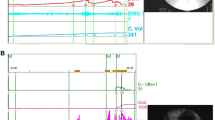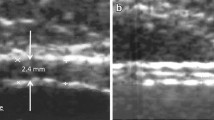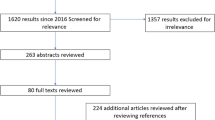Abstract
Introduction and hypothesis
A systematic review was carried out to study the hypothesis that bladder wall thickness (BWT) on ultrasound is accurate in diagnosing detrusor overactivity (DO).
Methods
Databases were searched from database inception to January 2009. Two reviewers independently selected articles and extracted data on study characteristics, quality and results.
Results
Five out of 190 screened studies were included. There were variations in the quality, methods of performing the ultrasound and urodynamics studies, and the format of reporting findings. BWT was more in women with DO than those with other types of incontinence in four out of five studies. Using a 5-mm cutoff (two studies), sensitivity varied between 40% and 84%, and specificity 78–89%.
Conclusions
There is lack of data to reliably estimate accuracy of BWT in DO.


Similar content being viewed by others
Abbreviations
- BWT:
-
bladder wall thickness
- DO:
-
detrusor overactivity
- OAB:
-
overactive bladder
- ROC:
-
receiver operating characteristic
- UDS:
-
urodynamics studies
- UI:
-
urinary incontinence
- USS:
-
ultrasound scan
References
Haylen BT, de Ridder D, Freeman RM, Swift SE, Berghmans B, Lee J, Monga A, Petri E, Rizk DE, Sand PK, Schaer GN (2010) An International Urogynecological Association (IUGA)/International Continence Society (ICS) joint report on the terminology for female pelvic floor dysfunction. Neurourol Urodyn 29(1):4–20
Martin JL (2006) Systematic review and evaluation of methods of assessing urinary incontinence. Health Technol Assess 10(6):1–132
Irwin DE, Mungapen L, Milsom I, Kopp Z, Reeves P, Kelleher C (2009) The economic impact of overactive bladder syndrome in six western countries. BJU Int 103(2):202–209
Martin JL, Williams KS, Sutton AJ, Abrams KR, Assassa RP (2006) Systematic review and meta-analysis of methods of diagnostic assessment for urinary incontinence. Neurourol Urodyn 25(7):674–683
National Collaborating Centre for Women's and Children's Health (2006) Urinary incontinence- the management of urinary incontinence in women
Irwin DE, Milsom I, Hunskaar S, Reilly K, Kopp Z, Herschorn S (2006) Population-based survey of urinary incontinence, overactive bladder, and other lower urinary tract symptoms in five countries: results of the EPIC study. Eur Urol 50(6):1306–1314
Basra R, Kelleher C (2007) Disease burden of overactive bladder: quality-of-life data assessed using ICI-recommended instruments. Pharmacoeconomics 25(2):129–142
Parsons M, Williams M, Cardozo L (2003) Anxiety during urodynamics. Int Urogynecol J Pelvic Floor Dysfunct (Supplement S10)
Latthe PM, Foon R, Toozs-Hobson P (2008) Prophylactic antibiotics in urodynamics: a systematic review of effectiveness and safety. Neurourol Urodyn 27(3):167–173
Sendag F, Vidinli H, Kazandi M, Itil IM, Askar N, Vidinli B, Pourbagher A (2003) Role of perineal sonography in the evaluation of patients with stress urinary incontinence. Aust NZ J Obstet Gynaecol 43(1):54–57
Haylen BT, Lee J (2008) The accuracy of post-void residual measurement in women. Int Urogynecol J Pelvic Floor Dysfunct 19(5):603–606
Minardi D, Piloni V, Amadi A, El AZ, Milanese G, Muzzonigro G (2007) Correlation between urodynamics and perineal ultrasound in female patients with urinary incontinence. Neurourol Urodyn 26(2):176–182
Yang JM, Huang WC (2003) Bladder wall thickness on ultrasonographic cystourethrography: affecting factors and their implications. J Ultrasound Med 22(8):777–782
Khan KS, Dinnes J, Kleijnen J (2001) Systematic reviews to evaluate diagnostic tests. Eur J Obstet Gynecol Reprod Biol 95(1):6–11
Irwig L, Tosteson AN, Gatsonis C (1994) Guidelines for meta-analyses evaluating diagnostic tests (see comment). Ann Intern Med 120(8):667–676
Deeks J (2001) Systematic reviews in health care: systematic reviews of diagnostic and screening tests. BMJ 323:157–162
Bossuyt PM, Reistma JB, Burns DE, Gastsonis CA, Glasziou PP, Irwig LM (2003) Towards complete and accurate reporting of studies of diagnostic accuracy: the STARD initiative. BMJ 326:41–44
Whiting P, Rutjes A, Reitsma J, Kleijnen J (2003) The development of QUADAS: a tool for the quality assessment of studies of diagnostic accuracy included in systematic reviews. BMC Med Res Methodology 3(1):25
Honest H, Khan KS (2002) Reporting of measures of accuracy in systematic reviews of diagnostic literature. BMC Health Services Research 2(1):4
Kolbl H, Bernaschek G (1990) Introital sonography—a new method in bladder function diagnosis. Geburtshilfe Frauenheilkd 50(4):295–298
Koelbl H, Bernaschek G, Deutinger J (1990) Assessment of female urinary incontinence by introital sonography. J Clin Ultrasound 18:370–374
Fukui J, Nakama M (1992) The role of urodynamic study in female patients with urinary incontinence. Acta Urologica Japonica 38(12):1369–1372
Blatt AH, Titus J, Chan L (2008) Ultrasound measurement of bladder wall thickness in the assessment of voiding dysfunction. J Urol 179(6):2275–2278
Lekskulchai O, Dietz HP (2008) Detrusor wall thickness as a test for detrusor overactivity in women. Ultrasound Obstet Gynecol 32(4):535–539
Robinson D, Anders K, Cardozo L, Bidmead J, Toozs-Hobson P, Khullar V (2002) Can ultrasound replace ambulatory urodynamics when investigating women with irritative urinary symptoms? BJOG 109(2):145–148
Khullar V, Cardozo LD, Salvatore S, Hill S (1996) Ultrasound: a noninvasive screening test for detrusor instability. BJOG 103(9):904–908
Moher D, Liberati A, Tetzlaff J, Altman DG, PRISMA Group (2009) Preferred reporting items for systematic reviews and meta-analyses: the PRISMA statement. J Clin Epidemiol 62(10):1006–1012
Khan KS, Kunz R, Kleijnen J, Antes G (2003) Systematic reviews to support evidence-based medicine—how to review and apply findings of healthcare research. Royal Society of Medicine Press, London
Rutjes AW, Reitsma JB, Coomarasamy A, Khan KS, Bossuyt PM (2007) Evaluation of diagnostic tests when there is no gold standard. A review of methods. Health Technol Assess 11(50: iii):ix–51
Acknowledgements
We would like to thank Derick Yates, librarian at Birmingham Womens' Hospital NHS Trust, for carrying out the literature searches on our behalf.
Contribution to authorship
PML conceived the idea for the review, wrote the protocol, retrieved some of the identified papers, acted as the first reviewer, and completed data and quality extraction. RC retrieved the remainder of the relevant papers and acted as the second reviewer to complete data and quality extraction. RC also wrote the initial draft of the manuscript. PML and RC then together wrote all subsequent drafts. KSK acted as a third reviewer, if and when consensus could not be reached between PML and RC. KSK also provided input to the statistical analysis and preparation of the manuscript.
Details of ethics approval
No ethical approval was needed for this review.
Funding
No funding was sought for this review.
Conflicts of interest
None.
Author information
Authors and Affiliations
Corresponding author
Rights and permissions
About this article
Cite this article
Latthe, P.M., Champaneria, R. & Khan, K.S. Systematic review of the accuracy of ultrasound as the method of measuring bladder wall thickness in the diagnosis of detrusor overactivity. Int Urogynecol J 21, 1019–1024 (2010). https://doi.org/10.1007/s00192-010-1144-y
Received:
Accepted:
Published:
Issue Date:
DOI: https://doi.org/10.1007/s00192-010-1144-y




